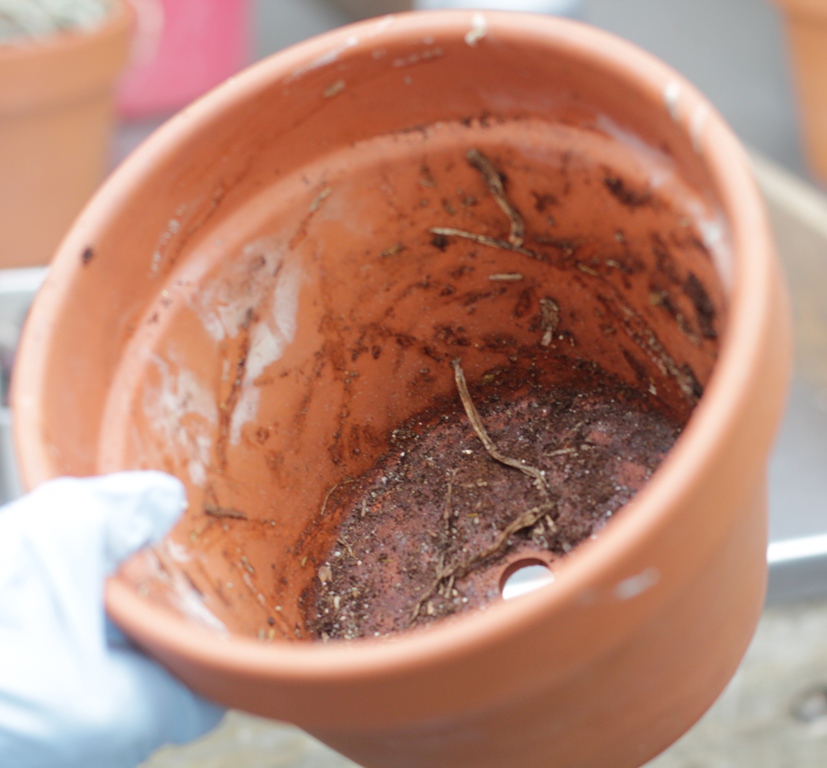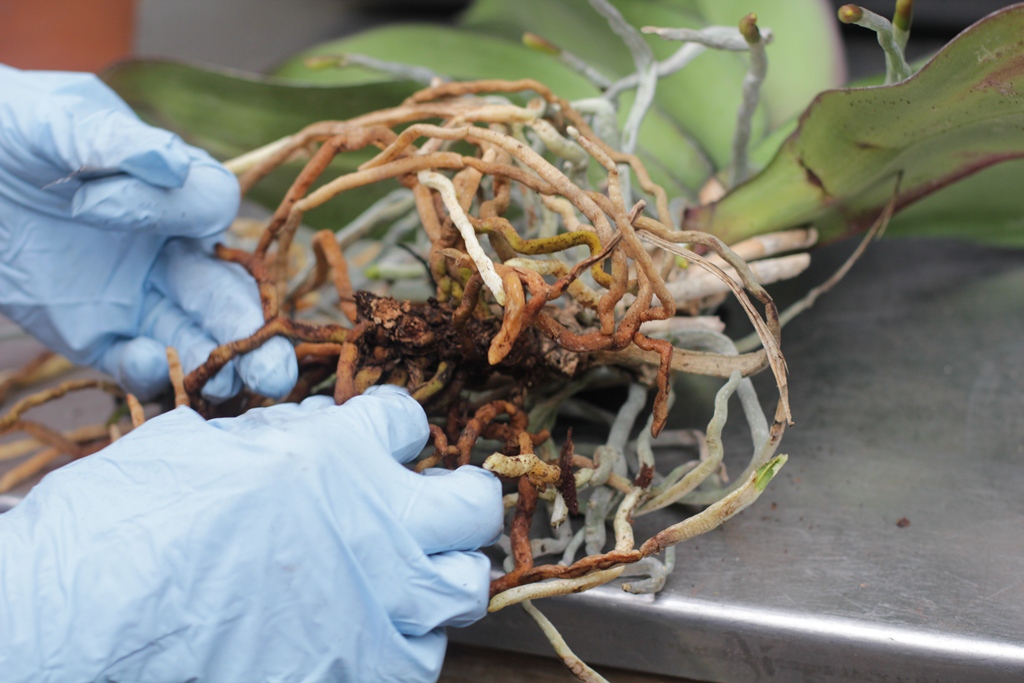
Moth orchids (Phalaenopsis) |
What is a monopodial orchid?
Monopodial orchids, such as, moth orchids (Phalaenopsis), have a main stem that grows upward from a single point. New leaves (usually only one or two) are produced each year at the top of the main stem. Meanwhile the lower leaves die off eventually creating a leggy, top heavy plant with copious aerial roots hanging downward. Flowers are produced from the leaf axil at the main stem. |

Leggy: needs repotting

Never repot when in bloom |
When to repot
Choose a plant that needs to be repotted. For monopodial orchids (e.g., Phalaenopsis) this is when the lower leaves die, making the plant too leggy and the stem weak. Also plants should be repotted when the chunks of bark in the potting mix have decomposed, becoming too fine and soil-like. As a general rule, repot plants every two years after flowering and when new growth appears. Usually a plant will lose one or two leaves at the bottom every year and gain one or two leaves at the top. Repot spring through fall.
Do NOT repot orchids that are in bloom no matter how much they seem to need it; they will lose their flowers. Wait until they have finished blooming and new growth appears. |
 |
Gather required materials
- Purchase commercial potting medium designed for moth orchids or make your own (our recipe follows)
- Plastic, latex or rubber gloves
- Pruners (sharp and sterilized between plants)
- New razor blade
- Scissors
- Suitable pot (discussion follows)
- Label
|
 |
Potting medium recipe
Many orchid growers make their own potting medium. Not all use the same ingredients or the same combination of ingredients. Here is the mixture used at the Missouri Botanical Garden for growing moth orchids (Phalaenopsis):
- 5 parts fresh fir bark, medium grade (¼ to ½ inch chunks) - NOT landscape mulch!
- 1 part horticultural charcoal (not the same as charcoal for barbecues). Note: This ingredient is extremely important as it neutralizes fertilizer salts.
- 1 part sponge rock (perlite)
|

Cleaned, sterilized & dried

Used pots should be cleaned and sterilized |
Select a suitable pot
Container size is important because most orchids are more likely to flower well if kept moderately pot-bound. For monopodial types, choose a container which just accommodates the root system and does not require bending or wrapping the roots to fit the plant inside. If the pot is too large for the plant, the roots will rot because the excess medium retains too much water. Special pots with slits along the sides are not necessary but may be used.
The choice of which container, plastic or clay, depends upon the grower. Plastic pots retain moisture longer, are lightweight and inexpensive. Clay pots will tend to dry out the potting medium quicker. However, clay pots are preferable for 2 reasons: 1) bulky orchids with lots of top growth need the weight of clay to anchor the plant down and prevent toppling and 2) because clay is porous and dries out faster, it helps prevent root rot by allowing more air into the root zone.
In any case, if reusing a pot, soak it 1 to 2 hours in hot soapy water containing chlorine bleach (1 part bleach to 9 parts water). Scrub clean, then rinse well and let dry. If re-using a clay pot, the drying period must extend at least 2 days in order to completely outgas the chlorine, which will be harmful to the roots. |

 |
Remove the plant from the pot
Grasp the plant by the stem and gently work it out of the pot. The more root-bound the plant, the harder it will be to get it out. On occasion, it may be necessary to break the pot to prevent damage to the plant. (a good reason to repot regularly--every 2 years). |
 |
Remove the old potting medium
The objective is to remove as much of the old potting medium as possible by shaking and picking out the pieces of bark. Pieces can also be washed out with tepid water. Be careful not to damage any living plant tissue and do not reuse potting medium. |

 |
Remove dead leaves
Using your hands, peel off dead or dying leaves. Usually a plant will lose one or two leaves at the bottom of the plant every year and gain one or two leaves at the top.
Also, peel off or pull off any dead tissue on the stem left behind after leaves were removed. |
 |
Remove dead bloom stalks
Again using your hands or pruners, remove all dead bloom stalks |

Hollow roots are dead roots

Wiry roots are dead roots

Soft tissue is dead tissue |
Remove dead roots and other tissue
Using a new, sharp razor blade, cut off all dead tissue from the roots. If in doubt of what is dead or alive, gently squeeze the roots. Dead tissue is hollow when squeezed or looks wiry. Live tissue is solid. If the entire root is dead, remove the entire root.
Remove any of the stem extending below live roots with a pair of sharp pruning shears. |
 |
Prepare the pot
Cover the bottom of the pot with a thin layer of the premixed potting medium. |


 |
Place the plant in the pot
Select a pot that will accommodate the roots and potting medium, then gently place the roots in the pot, keeping the plant centered in the pot. Align the roots and slide them down into the pot until the base of the bottom leaf is slightly above the rim of the pot. |

 |
Fill with potting medium
Gently place or push potting medium into the air spaces around the roots, leaving no air pockets. Continue until the level of the potting medium is just below the base of the lower leaves. Press gently to firm the potting medium in place. |

RP 9/14 = Repotted September, 2014

Loosely attach the label to the plant |
Label the plant
All plants should be labeled with the complete Latin name. Although still lovely, a plant without a label is valueless in the trade. Knowing the Latin name of a plant can also help if problems or questions arise.
A great help in maintaining orchids is writing on the label the month and year of repotting. It can also help to include the date that the plant bloomed. If it has not bloomed in three years, it may be time to pitch it or give it to a friend who may have more suitable growing conditions.
Loosely attach the label to the plant or insert it along the inside rim of the pot. This prevents the label from getting lost or separated from the plant. Never discard the original label.
Serious orchid growers also keep a log book of their plants containing information on when and where they acquired each plant, when they bloomed and when they were repotted. |
 |
Water
Be sure to water the plant thoroughly after repotting. Tepid water is best; cold water will harm the roots. One method is to soak the plant, pot and all, in a bucket of tepid water for an hour or so.
NEVER use ice cubes to water orchids or any other plant. All plants prefer tepid (room temperature) water, especially tropical plants. Ice can injure roots and stems, leading to root rot and eventual death of the plant, just as an early frost in Spring can kill tender plants outdoors. Furthermore, when watering, water thoroughly, getting all the potting medium moist; allow it to drain completely; then discard any water left in the drip pan. |
 |
On-going maintenance
For information on the day-to-day care of orchids, see the Kemper Center Factsheet “Orchids: Culture.”
For pests and problems with orchids, see the Kemper Center Factsheet “Orchids: Problems.” |